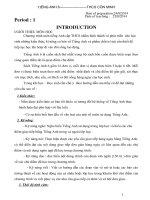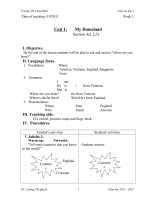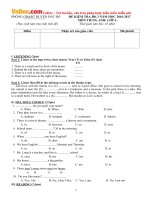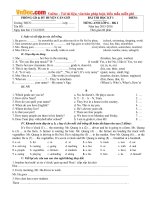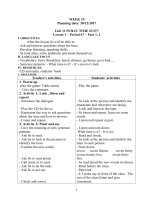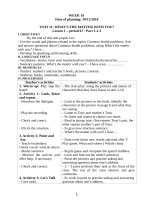Giáo án tiếng anh lớp 6 chọn bộ theo chương trình PTNLHS giáo án cả năm xuân nguyễn thị unit (9)
Bạn đang xem bản rút gọn của tài liệu. Xem và tải ngay bản đầy đủ của tài liệu tại đây (302.22 KB, 18 trang )
GIAOANDETHITIENGANH.BLOGSPOT.COM
UNIT 9: CITIES OF THE WORLD
Lesson 1: Getting Started – What nice photos!
I. Objectives:
By the end of the lesson sts can; use the lexical items related to the topic ‘Cities of the
World’; use the vocabulary and structures to describe cities and landmarks.
II. Language contents:
1. Vocabulary: the lexical items related to the topic “Cities of the world”.
2. Grammar: The present perfect tense
III. Methods: Communicative approach
IV. Teaching aids: Text book, picture, tape, cassette, board, chalk.
V. Procedures:
Teacher’s activities
Students’ activities
Contents
I. Warm-up:(5’)
Go- went; Play – played
- Have sts write these verbs in to past
- Go to the board and write
Do – did; speak –spoke; write
form
Go- went; Play – played
– wrote; read - read
Go; play; do; speak; write; read
Do – did; speak -spoke write –
Visit - visited
Visit; watch; be; take; start; eat have
wrote; read - read
watch – watched
Visit - visited
be – was/were; eat – ate; have watch – watched
had
be – was/were
II. Presentation
take- took; start – started;
take- took; start - started eat
- Ask ss to look at the picture and answer – ate; have - had
Unit 9: CITIES OF THE WORLD
the questions
- Listen and answer
1. Listen and read.
?What are they?
-They
are
cities
of
the
world
* Vocabulary:
?Do you know which cities they are ?
-They
are
Sydney,
Big
Ben……
- Ask ss to listen and answer
- exciting(a) [ik'saitiη]: lý thú
- Listen and answer
True or False ?
- clean(a) [kli:n]:sạch
1. The photos are nice
- bad(a) [bæd] : xấu
2. Rio de Janeiro isn’t an exciting city
1. T
- beautiful(a) ['bju:tiful]:đẹp
3. Sydney isn’t so hot
2. F
4. The beaches in Sydney are the
- modern(a) ['mɔdən]:hiện đại
3. F
cleanest and the most beautiful.
- eggs-shaped(a)[eg-∫eipt]: hình
4. T
5. There aren’t also modern buildings,
5. F
bầu dục
like this egg- shaped building
III. Practice
* Answer key:
- Ask sts look at exercise 2.
1. The photos are nice
- Have sts reread the dialogue and do
2. Rio de Janeiro isn’t an
exercise 2.
exciting city
- Allow sts to share answers before
discussing as a class
3. Sydney isn’t so hot
- Ask sts to support their answer
4. The beaches in Sydney are the
- Look at the exercise 2
- Have sts look at the map
cleanest and the most beautiful.
reread the dialogue and do
- Ask ss
exercise 2.
5. There aren’t also modern
?How many continents are there in the
world?
- Share answers before
buildings, like this egg- shaped
GIAOANDETHITIENGANH.BLOGSPOT.COM
?What are they?
- Ask ss to look at the pictures and
names the continents
- Ask them to translation these names in
Vietnamese
IV. Further- practise
- Write ‘Asia, Viet nam, Hue, Ha Noi,
Thong Nhat Palace’ on the board.
- Ask sts
? Which is the continent?
? Which is the country/ city/ capital?
? Which is the place of interest?
- Ask ss to read all words and match
V. Production
- Have sts play a game “ Around the
world”
- Divide sts into 2 big groups
- Give sts more questions in addition to
those in the book
? Which continent is it in?
? What is its capital?
? What are its major cities?
? What is it famous for?
VI. Homework:
- Learn by heart new words.
- Prepare A closer look 1.
discussing as a class
- Support their answer
- Look at the map
- Listen and answer
- There are 6
- Asia, Africa, Australia,
Antarctica, America, Europe,
- Look at the pictures and
names the continents
- Translation these names in
Vietnamese
- Look at the board
building
1
2
3
4
5
T
F
F
T
F
2. Read the conversation
again. Then write True/ False
1. F (They are looking at photos
on the computer.)
2. F (Tom has been to most of
the cities.)
3. T
4. F (There are modern
buildings in London as well.)
5. F(Tom has never been to New
- Answer
York. The photo is from his
- Asia,Africa
brother.)
- Sweden/ Nha Trang/ Ha Noi
3. Name the continents
- Ben Thanh market
1. Asia
- Read all words then work in
pairs to match the words to the 2. Europe
3. Africa
names of the places
- Play a game
4. North America
5. South America
6. Australia
7. Antarctica
4. Match the words in the blue
box to the names of the places.
* Vocabulary:
- continent (n)['kɔntinənt]: lục
địa, châu âu
a. continent: Asia,Africa
b. Country: Sweden, the USA
c. City: Nha Trang, Amsterdam,
Liverpool, Ha Noi
d. capital: Amsterdam, Ha Noi
e. Place of interest: Ben Thanh
market, the Louvre
5. Game: “Around the world”
*Homework
Experiments:
............................................................................................................................................................
............................................................................................................................................................
GIAOANDETHITIENGANH.BLOGSPOT.COM
............................................................................................................................................................
............................................................................................................................................................
............................................................................................................................................................
............................................................................................................................................................
............................................................................................................................................................
............................................................................................................................................................
Week: 25
Date of planning: ……/……/
Period: 70
……
Date of teaching: ……/……/……
UNIT 9: CITIES OF THE WORLD
Lesson 2: A Closer Look 1
I. Objective:
By the end of the lesson sts can pronounce the souds /əʊ/ and /ai/ correctly in isolation and
in context; use the lexical items related to the topic “ ‘Cities of the World’.
II. Language contents:
1. Vocabulary: the lexical items related to the topic “Cities of the world”.
2. Grammar: The Past Simple
III. Methods: Communicative approach
IV. Teaching aids: Text book, picture, tape, cassette, board, chalk.
V. Procedures:
Teacher’s activities
I. Warm-up:(5’)
- Ask ss some questions.
? Do you remember about Mai and
Tom?
? Which cities did Mai and Tom talk
about at the begining of the unit?
? How did Tom describe the three
cities?
? What did he talk about?
? Which adjectives did he use?
- Introduce the lesson.
II. Presentation:(10’)
- Ask ss to read all the words and
work in groups to do matching in 1.
- Ask ss to go to the board and
match.
- Have other sts check.
- Ask sts to read the words again.
- Give feedback.
- If have time ask sts to use the
adjectives to describe the three
Students’ activities
Contents
- Listen and answer.
- Yes/ no
- Rio de Janeiro, Sydney, and
new York
- Rio de Janeiro is exciting,
it’s very hot. Sydney isn’t so
hot, the beaches in Sydney
are clean and beautiful.
London has bad weather,
there are also modern
buildings.
- The weather, the beaches
and the buildings.
- exciting, hot, clean,
beautiful, bad, modern
- Listen and write.
- Read all the words and
match the words in A with
their opposites in B.
Unit 9: (Continued)
Lesson1: A closer look 1
* VOCABULARY
1. Match the words in A with
GIAOANDETHITIENGANH.BLOGSPOT.COM
cities that Mai and Tom talked
about.
III. Practice:(15’)
- Ask sts look all the words and guide
ss how to do exercise
? Which words can you use to
describe “city” ?
Food?
People?
Building?
Weather?
- Have sts work in groups.
- Tell them can use the words in 1encourage sts to add other
adjectives.
- Give feedback.
- Point out that some adjs can’t go
with particular nouns. We can not
say
Ex: long/ short city
Rainy people
- Have practise the /əʊ/
and /ai/sound together in 3.
- Model the two sounds with cold
and sky.
- Let sts see how the sounds are
formed.
- Ask sts to give words that have
these two sounds.
- Play the recording and ask sts to
listen and fill in the suitable column.
- Play the recording again and have
sts give the answer.
IV. Further- practise: 14’
- Ask ss to listen and repeat
* GRAMMAR
- Ask ss to look at all the pictures.
- Give example
- Ask sts to work individually to
complete the fact sheet, using one
of the pictures provided
- Have sts work in pairs compare the
answer.
- Ask them to discuss whether they
agree with each other’s answers (if
thye don’t not agree the answers,
encourage them to give reasons.
Don’t give corrective feedback at this
stage)
- Have sts ask and answer questions
about the fact using Most +
- Go to the board and match.
- Check
- Read again
- Write
- Use the adj to describe the
three that Mai and Tom
talked about.
- Listen and remember
listen and answer
Beautiful, old…
Delicious,cheap..
Beautiful…
Modern, historic...
Cold, hot…..
- Work in groups.
- use the words in 1to add
other adjectives.
- Takenote.
- Listen and note.
- Read all the sentences
- Listen
- See how the sounds are
formed.
- Give words that have these
two sounds.
- Listen and fill in the
suitable column.
-
Give the answer
- Write and repeat.
- Read all the sentences
their opposites in B. Some words
may have more than one
opposite.
1. old – new
2. dangerous – safe
3. quiet – noisy
4. dry – wet
5. boring – exciting
6. clean – dirty
7. historic – modern
8. cheap – expensive
9. cold – hot
Ex:
- The beaches in Sydney are clean
and beautiful.
- London has bad weather.
2. Created the webs
1. City: beautiful, peaceful,
exciting, modern, big, poluuted,
safe,….
2. People: nice, friendly,
unfriendly, open, noisy, interesting,
…
3. Food: delicious, awful, good,
tasty,….
4. Weather: bad, rainy, hot, cold,
wet,…
5. Building: old, modern, tall,
new,…
* PRONUNCIATION
/əʊ/ and /ai/
3. Listen and write the words
you hear in the appropriate
column. Then read the words
aloud.
/əʊ/
Cold
/ai/
Sky
GIAOANDETHITIENGANH.BLOGSPOT.COM
adjectives.
- Encourage sts to expand the fact
sheet by adding information like:
Ex: The most famous woman in
Britain
The most well-known novel/ movie.
The most famous footballer/ actor/
actress.
The most popular sports,…
- Ask sts to remember how the
comparatives of long adjectives are
formed.
- Write the form of the suparlatives
of long adjectives on the board.
V. Homework: (1’)
- Practise the soud /əʊ/ and /ai/
- Prepare A closer look 2.
- Look at all the pictures.
- Listen and write
- Work individually to
complete the fact sheet,
using one of the pictures
provided
work individually to complete
the fact sheet, using one of
the pictures provided
- Work in pairs compare the
answer.
- Discuss whether they agree
with each other’s answers
- Look at their earlier answer.
- Ask and answer questions
about the fact using most +
adjectives.
Ex: Sydney is the most
exciting city.
There are the most beautiful
beaches.
- Remember how the
comparatives of long
adjectives are formed.
- Write the form of the
suparlatives of long
adjectives
S + the + most + adj
There are the most beautiful
beaches.
- Find the superlatives in the
text in 6
Snow
Old
Clothes
Hold
Exciting
High
Fine
Flight
4. Listen and repeat
* GRAMMAR
Comparative
a. Short adjectives
Lan is taller than Hoa
This book is thiner than that book
b. Long adj
She is more beautiful than her
sister
Car is more comfortable than bus
- Superlative
a. Long adj
The red bag is the most expensive
than the black bag
Hoa is the most beautiful in her
class
5. Complete the fact sheet by
choosing one picture. Compare
your fact sheet with a classmate.
Do you agree with his/ her
answer?
* Key:
1. London 2. Oxford University
3. Shakespear 4. fish and chips
5. tea
5. watching TV
6. Read this article about
Britain. Then, look at your fact
sheet. Did you have correct
answers?-
GIAOANDETHITIENGANH.BLOGSPOT.COM
*Homework
- Practise the soud /əʊ/ and /ai/
- Prepare A closer look 2.
GIAOANDETHITIENGANH.BLOGSPOT.COM
Week: 25
Date of planning: ……/……/……
Period: 71
Date of teaching: ……/……/……
UNIT 9: CITIES OF THE WORLD
Lesson 3: A Closer Look 2
I. Objective:
By the end of the lesson sts can pronounce the souds /əʊ/ and /ai/ correctly in isolation and
in context; use the lexical items related to the topic “ ‘Cities of the World’.
II. Language contents:
1. Vocabulary: the lexical items related to the topic “Cities of the world”.
2. Grammar: The Past Simple
III. Methods: Communicative approach
IV. Teaching aids: Text book, picture, tape, cassette, board, chalk.
V. Procedures:
Teacher’s activities
I. Warm-up:(5’)
- Check vocabulary in A closer look 1
- Ask ss to go to the board and write
the adjectives.
- Check and have them repeat these
words
II. Presentation:(10’)
- Ask sts to recall what Tom told Mai
about in the conversation in Getting
started.
- Ask sts to underline all the verbs in
the present perfect tense.
- Use the Grammar box to help you
explain that present perfect is used
to show that one has had or has
never had this experience.
- Provide the form of the present
perfect.
- Notice the past particple.
- Ask sts to look for the original verb
of the past participles in the
conversation.
- Notice the use of “never” and
“ever”.
- Have sts play a game: Write the list
of verbs on the board. Divided sts
into two groups and get them to the
board and write the past participles
of the verbs.
Students’ activities
- Go to the board and
write
Contents
Unit 9: (Continued)
Lesson 3: A closer look 2
1. Listen again to part of the conversation.
- Check and repeat
Pay attention to the present perfect.
* GRAMMAR:
Go
watch
See
be
- Recall what Tom told
Mai about in the
Do
take
conversation in Getting
Speak
start
started.
Write
eat
- Underline all the
read
have
verbs in the present
Visit
take
perfect tense.
* The present perfect tense.
- Read the Grammar
Use : We use the present perfect to
box
describe our experiences
Formation: S + has/have + past
- Write
participle
Ex:
- Listen and remember (+) I have seen that movie ten times
- Look for the original
She has watched TV for 30 minutes
verb of the past
(-) I haven’t seen that movie
participles in the
She hasn’t watched TV
conversation.
- Listen and remember (?) Have you ever seen that movie?
Has she gone to HN?
- Play a game
- Go to the board and
write the past
participles of verbs.
GIAOANDETHITIENGANH.BLOGSPOT.COM
- Check and give mark for each team
- Have them repeat the verbs
III. Practice:(18’)
- Ask ss to read all the sentences and
work in pairs to do exercise
- Ask ss to give the answer
- Ask ss to read all the sentences and
work in pairs to do exercise
- Ask ss to give the answer
IV. Further- practise: 5’
- Ask ss to look at the picture and
answer
? Can you tell me what he does in
the picture?
- Ask ss to tell what Tom has done
this week
- Ask ss to give the answer
- Use all the question in 5 to ask ss to
find out one thing that everyone has
done and one thing no one has done
- Listen
- Repeat.
- Read all the sentences
- Go to the board and
write the answer
- Read all the sentences
- Go to the board and
write the answer
- Look at the picture
and answer
- reading book
- having breakfast
- getting good grade
- playing football
- Listen and answer
2. Put the verbs in the brackets in to
the present perfect.
1. has been
2. has been
3. has visited
4. has been
5. hasn’t been
3. Put the verbs in the brackets in
the correct for
1. have you seen….I have seen…
2. go
3. have never been
4. clean
5. takes
6. has eaten
4. Look at Tom’s webpage. Tell a
partner what has he done this week
1. He has read a book.
2. He has eaten “pho”.
3. He has played football.
4. He has got an A+.
5. He has washed his dog.
5. Class survey
*Homework
- Complete the exercises into
notebooks
- Prepare Communication.
UNIT 9: CITIES OF THE WORLD
Lesson 4: Communication
GIAOANDETHITIENGANH.BLOGSPOT.COM
I. Objectives:
By the end of this lesson, students will able to identify landmarks in cities around the world and
compare features of cities around the world.
II. Language contents:
1. Vocabulary: the lexical items related to the topic “Cities of the world”.
2. Grammar: Comparatives of adjectives, Possessive case
III. Methods: Communicative approach
IV. Teaching aids: Text book, picture, tape, cassette, board, chalk.
V. Procedures:
Teacher’s activities
I. Warm up (5’)
- Have sts play “Matching”
A
B
Design
Di sản VHTG
Symbol
Thiết kế
Landmark
Biểu tượng
Creature
Danh thắng
UNESCO
S V, tạo vật
World Heritage
II. Presentation: (10’)
- Teach vocabulary.
- Have sts read chorus.
- Show the pictures of the five
landmarks and ask sts
? What are they?
- If sts don’t know their names in
English, allow sts to use
Vietnamese.
? What do you know about them?
1. Is Merlion in Singapore?
2. Where is Big Ben?
3. Was the Temple of Literature
built in 1070?
4. Where is Sydney Opera House?
5. Is Eiffel Tower in Paris?
- Give the English names and ask
sts to match them with the photos
- Ask students to work in pairs and
match.
III. Practice:(18’)
Sts’ activities
- Play “matching”
game.
- Listen and write
- Read
- Look at the pictures
and answer
They are Big Ben, Eiffel
tower, Sydney Opera
House…
Yes/
It’s in England
Yes
It’s in Australia
Yes
- Work in pairs and
match.
- Listen and match
- Work in pairs
- Listen and repeat
then write
- Read individual.
- Work in pairs and
Contents
Unit 9: (continued)
Lesson 4: Communication.
- Answer:
A
B
Design
Thiết kế
Symbol
Biểu tượng
Landmark
Danh thắng
Creature
S V, tạo vật Di
UNESCO
sản VHTG
World Heritage
* Vocabulary:
- design [di'zain](v): Thiết kế
- Symbol (n)
- Landmark ['lændmɑ:k](n): Danh
thắng
- Creature ['kri:t∫ə](n): Sinh vật
- UNESCO[ju:`neskou] World Heritage
(n): (United Nations Educational,
Scientific and Cultural Organization):
tổ chức GD, KH và VH của Liên hợp
quốc.
1. Match the words in the box with
the landmarks. Which cities are they
in? What do you know about them?
a. Merlion [mə:liən]
b. Big Ben
c. The Temple of Literature
d. Sydney Opera House
e. Eiffel Tower[`tauə]
GIAOANDETHITIENGANH.BLOGSPOT.COM
match words with the
- Ask ss to look at part 2. Then
meaning.
introduce new words.
- Work in pairs and
- Ask ss to read new words.
read.
- Ask ss to work in pairs and
- Read and give answer.
- Read the texts again
match words with the meaning
and do exercise.
- Ask ss to read the texts in the
- Give answer.
book and guess which landmark
- Play game in group
from 1 they are.
thinks of a city, a
- Have ss some ss read and give
country, or a landmark
and give clues to other
answer.
guess.
- Ask ss to read the texts again
and then do exercise: write true or
false.
- Ask some students to give
answer.
Listen and write
IV. Further- practise: 5’
- Ask ss to to play game.
( each group thinks of a city, a
country, or a landmark and give
clues to other guess. Example:
A: It’s a city. It’s very hot and
crowded.
B: Is it Tokyo?
A: No, it’s not. It’s in South
America. The people there love
football.
B: Is it Rio de Janeiro?
A: Yes, it is!
V. Homework(1’)
Ask ss to write home work
2. Read about the landmarks. Can
you guess which landmark from 1
they are?
- describe [dis'kraib](v):miêu tả
- head[hed](n): cái đầu
which landmark from 1 they are?
1. Big Ben
2. Sydney Opera House
3. Temple of Literature
4. Eiffel
5. Merlion
3. Write true (T) or false (F)
1. F (The Bell in the tower is the largest
bell ever made in England).
2. F (It was designed by a Danish
architect)
3. T
4. F (It is the most visited land mark in
the world)
5. T
6. F (It has a lion’s head and a fish’s
body)
4. Think of a city, a country, or a
landmark. Give clues.
Example:
A: It’s a city. It’s very hot and
crowded.
B: Is it Tokyo?
A: No, it’s not. It’s in South
America. The people there love
football.
B: Is it Rio de Janeiro?
A: Yes, it is!
*Homework
- Learn by heart all the new words.
- Do exercises (in workbook).
Prepare skills 1.
GIAOANDETHITIENGANH.BLOGSPOT.COM
UNIT 9: CITIES OF THE WORLD
Lesson 5: Skill 1
I. Objectives:
By the end of this lesson, students will able to read for specific and general information in texts,
including postcards, use the present perfect to talk about experiences.
II. Language contents:
1. Vocabulary: the lexical items related to the topic “Cities of the world”.
2. Grammar: Comparatives of adjectives, Possessive case
III. Methods: Communicative approach
IV. Teaching aids: Text book, picture, tape, cassette, board, chalk.
V. Procedures:
Teacher’s activities
I. Warm up (5’)
- Have sts look at the postcard in 1
in the book.
- Ask some questions.
1. What is the picture on the
postcard of?
2. What do you think is written on
this postcard?
3. What is the purpose of writing
and sending postcards while you
are on holiday?
II. Presentation: (10’)
- Teach vocabulary.
- Have sts read chorus.
- Have sts look at the questions in
2 and underline the key words in
the quetsions
- Ask sts to read the paragraph and
answer the questions
- Check and correct
III. Practice:(18’)
- Ask ss to read the texts again
and then do exercise 3
- Ask sts to match the heading with
the text.
Sts’ activities
- look at the postcard in
the book.
- Answer
1. Stockholm, Sweden.
2. about his/ her stay in
city.
3. to tell our family or
friends that we have a
good time
- Listen and write
- Read
- Look at the questions
and underline the key
words in the quetsions
- Work in pairs
- Takenote
- read the texts again
and then do exercise 3
- Work in pairs and
match the heading
withb the text.
- Call their attention to
how a postcard is
organized.
- Takenote
- Read and choose the
city they want
- work in groups sts can
not use full sentence.
- Give answer.
- Use the notes to work
Contents
Unit 9: (continued)
Lesson 5: Skills 1.
* READING: Love from Sweden.
1. Look at the postcard.
- Answer:
1. The photo is of Stockholm, Sweden.
2. The sender writer about his/ her stay
in the city.
3. We send postcards to tell our family
or friends that we are having a good
time, but we still miss them amd want
to send some photos of the place where
we are so that, although they cannot be
with us there they can still see how
beautiful it is.
* Vocabulary:
- perfect ['pə:fikt](a): hoàn toàn, đầy đủ
- palace ['pælis](n): cung điện
- amazing [ə'meiziη](a): ngạc nhiên
- rent [rent](v): thuê
- discover [dis'kʌvə](v): khám phá
- postcard ['poustkɑ:d](n): bưu thiếp
2. Read the postcard and answer the
questions.
1. Mai is in Stockholm.
2. She is there with her family (mum,
Dad and her brother Phuc)
3. The weather has been perfect. It is
sunny.
4. mai is staying in a hotel.
5. She has visited the Royal palace and
GIAOANDETHITIENGANH.BLOGSPOT.COM
in pairs and tell each
- Call their attention to how a
other about the city
postcard is organized.
they choose in 5
- Check and correct
IV. Further- practise: 6’
- Ask ss to look at the questions in
4 and choose one city they’ve
learn and then answer
- Ask them to work in groups sts
can not use full sentence.
- Have them practise in a class.
- Ask sts to use the notes to work
in pairs and tell each other about
the city they choose in 5.
- Make sure they speak in full
sentences.
.
- Speak in full
sentences.
had ‘fika’ in a café in the Old Town.
6. ‘Fika’ (a Sweden word) means a
leisure break when one drinks tea/
coffee and perhaps has some biscuits
with friends and family.
7. She will cycle to discover the city.
8. Mai is feeling happy. She used the
words such as “fantastic”, “perfect”,
“amazing”, “too beautiful for words”.
3. Read the text again and amtch the
heading with the numbers.
1. i
2. c 3. h 4. b 5. d
6. g 7. f 8. e 9. A
* SPEAKING.
4. Choose a city. Imagine you have just
arrived in that city and want to tell your
friends about it. Make notes below.
5. In pairs, use your notes to tell your
partner about your city. Then, listen and
write down notes about your partner’s
city in the space below.
*Homework
- Learn by heart all the new words.
- Do exercises (in workbook).
Prepare skills 2.
............................................................................................................................................................
............................................................................................................................................................
............................................................................................................................................................
GIAOANDETHITIENGANH.BLOGSPOT.COM
UNIT 9: CITIES OF THE WORLD
Lesson 6: Skill 2
I. Objectives:
By the end of this lesson, students will able to listen for specific details including facts and
figures; write a holiday postcard.
II. Language contents:
1. Vocabulary: the lexical items related to the topic “Cities of the world”.
2. Grammar: Exclamation sentence.
III. Methods: Communicative approach
IV. Teaching aids: Text book, picture, tape, cassette, board, chalk.
V. Procedures:
Teacher’s activities
I. Warm up (5’)
- Ask ss to look at the pictures in 1
and tell what they see
? What do you see in picture 1?
? Do you know about Nobel and
the Nobel Prize?
? Can you talk this in Vietnamese?
- Play the recording and ask them
to listen.
? How Nobel Prizes are awarded
every year in Stockholm?
II. Presentation: (10’)
- Ask ss to read all the sentences in
2 and guess T or F
- Explain the new words
- Ask ss to listen to the stereo
again and answer true or false
- Have sts correct the false
sentences.
Sts’ activities
P1: Royal Palace
P2: Nobel Prize
P3: museum, café,
restaurants, shops,..
P4: island
- Yes/ no
- Yes/ no
Unit 9: (Contunued)
Lesson 6: Skills 2
1. Look at the pictures. What do you see?
* Vocabulary:
- award[ə'wɔ:d](v): thưởng, tặng
(n): phần thưởng
- Listen to the
recording
-
- Read all the sentences
and guess T or F
- Listen and write
- Listen to the sterio
again and give the
answer
read all the sentences
- Listen to the stereo
again correct the false
sentences.
- Takenote
- Read all the sentences
in 3
- Listen
- Check and corect.
III. Practice:(10’)
Contents
2. Listen and write True or False?
* Vocabulary:
- prize [praiz] (n): giải, giải thưởng
- Nobel peace prize (n): giải Nobel hòa bình
- present ['preznt] (a): hiện diện
[pri'zent](v): đặt ra
- prime [praim] (n): đầu tiên
(a): ưu tú, xuất sắc
- minister ['ministə] (n): Bộ trưởng
1. T
2. F (The oldest, not the biggest, part of
Stockholm is the Old Town)
3. F (Today, the Old Town is a place with
cafes, restaurants, shops and museum)
4. F (All Nobel prizes, exept for the Nobel
Peace Prize, are awarded in Stockholm)
5. F (It is presented by the Swedish
['swi:di∫] King)Vua Thụy Điển.
GIAOANDETHITIENGANH.BLOGSPOT.COM
- Ask ss to read all the sentences in - Identify the kind of
information they have
3
- Explain to sts that this time they to find out: years,
amount of money,
need to listen for the exact details
number of people,
in the recording.
date,…
- Ask them to identify the kind of
- Listen
information they have to find out: - Listen again and fill in
years, amount of money, number
the gaps
of people, date,…
- Takenote
- Play the recording
- Ask ss to listen to the stereo
again and give the answer
- Check and corect.
IV. Further- practise: 14’
- Write 5 Ws and 1H on the board
- Ask sts to give examples
Ex: How is the Stockholm?
What is the weather like?
- Ask ss to read all the words in 4
and put them in the correct order
to make sentences
- Ask sts to use the notes they have
made in Speaking 4 to write a
postcard to their family or friends:
- Ask ss
Have you ever been to Ha Long
bay?
If you have never been to , let
imagine and write a post card
Follow these questions
Who do you write the post card
for?
When did you arrive?
Who are you with ?
Where are you staying?
What have you done?
What are you doing tomorrow?
How are you feeling?
- Who/ What/ When/
Where/ Why/ How
- Give examples
- Read all the words
- Make sentences
- Listen
- Answer
3. Listen again to the talk and fill in the
gaps.
* Vocabulary:
- cover ['kʌvə] (v): che, phủ, bao gồm
- prizewinner (n): người được giải
- consist [kən'sist] (v): gồm có
- diploma [di'ploumə](n): văn bằng, chứng
chỉ, bằng TN
- medal ['medl] (n): huân chương
- crown [kraun] (n):vòng hoa, mũ niệm
1. 14
2. 700
3. 3,000
4. 10 December
5. 10 million
Writing
4. Rearrange the words to make
sentences.
1. Stockholm is fantastic!
2. We’re in Da Lat!
3. We’re having a good time here!
4. I love Disneyland!
5. You must come!
6. I wish you were here!
5. Write a postcard . Use the notes about
the city you have chosen in speaking 4,
page 28
Home work
- Complete the exercise 5 into notebooks
- Prepare Looking back.
UNIT 9: CITIES OF THE WORLD
Lesson 7: Looking back
I. Objectives:
By the end of this lesson, students can review some vocabulary and grammar they’ve
learn in unit 9.
II. Language contents:
1. Vocabulary: the lexical items related to the topic “Cities of the world”.
2. Grammar: Review
III. Methods: Communicative approach
IV. Teaching aids: Text book, picture, tape, cassette, board, chalk.
V. Procedures:
Teacher’s activities
I. Warm up (5’)
- Ask ss some free questions
- Ask ss to go to the board and
complete the sentences
1. She ( watch) Tv for haft an hour
2. They ( not go) to HCM city yet
3. You ever ( play ) that game?
II. Presentation: (10’)
VOCABULARY
1. Choose the best options
- Ask ss to read all the sentences and
choose the best answer
GRAMMAR
2. Put the verb in the brackets into
the present perfect .
- Ask ss to read the dialogue in pairs
then put the verb in the brackets into
the present perfect
Ss’ activities
- Listen and answer
- Go to the board and
complete the
sentences
- Read all the
sentences and
choose the best
answer
- Work in pairs
1. Have…eaten
2. Have…been ….?
3. have been….
4. have been
5.Have…visited?
6. have seen
Language contents
1. She has watched Tv for haft an hour
2. They have not gone to HCM city yet
3. Have you ever played that game?
Unit 9: (Continued)
Lesson 6: Looking back
1. Choose the best options
1
2
3
4
a,b
a,c
a,c
a,b
5
b,c
GRAMMAR
2. Put the verb in the brackets into the
present perfect .
1. Have…..eaten….
2. Have……been ….?
3. have been….
4. have been
5. Have….visited…..?
6. have seen
- Try to answer
III. Practice:(10’)
3. In pairs, complete this fact sheet
about Viet Nam.
- Yes, I do
- HCM city
- Quoc Tu Giam
- Nam Cao
3. In pairs, complete this fact sheet
about Viet Nam.
COUNTRY: VIET NAM
Biggest city: HCM city
Oldest university: Quoc Tu Giam, Thang
- Ask ss some questions about Viet
Nam
Do you like our country?
Which is the biggest city in Viet
Nam?
Which is the oldest university in Viet
Nam?
Who is the most popular Vietnamese
writer?
What is the most popular food in Viet
Nam?
What is the most popular drink in
Viet Nam?
What is the most common activity in
Viet Nam?
IV. Further- practise: 14’
4. Using the information from your
fact sheet , write a short paragraph
(7-8 sentences) about Viet Nam.
- Ask ss to use the information from
3 to write a short paragraph about
Viet Nam
COMMUNICATION
5. Game: Yes I have
V. Home work(1’)
- Complete the exercises into
notebooks
- Prepare Review
- nem
- tea, coffee
- watching TV
Long – Ha Noi (1076)
Most popular Vietnamese writer:
Nguyen Du, Nam Cao
Most popular food: spring roll(nem),
noodles(phở)
Most popular drink: tea, coffee
Most common activity: watching TV,
football
- write a short
paragraph about Viet
Nam
4. Using the information from your fact
sheet , write a short paragraph (7-8
sentences) about Viet Nam.
COMMUNICATION
5. Game: Yes I have


